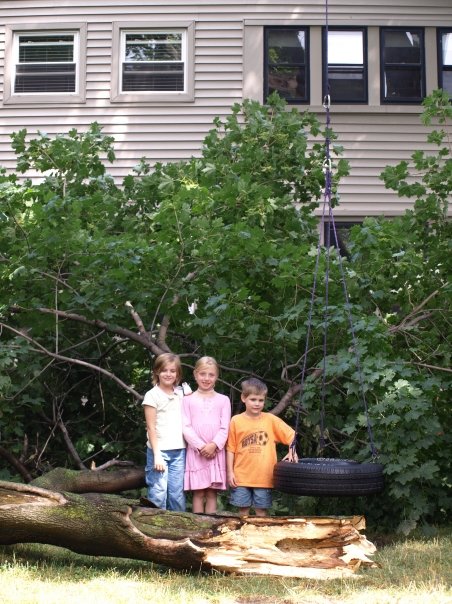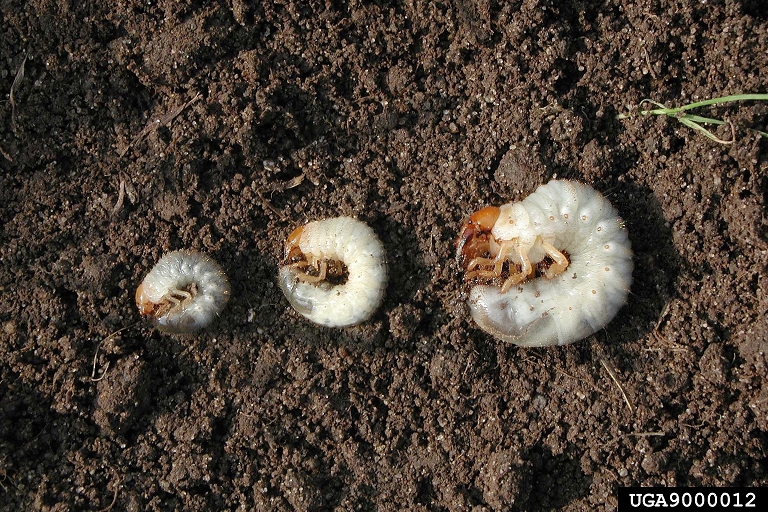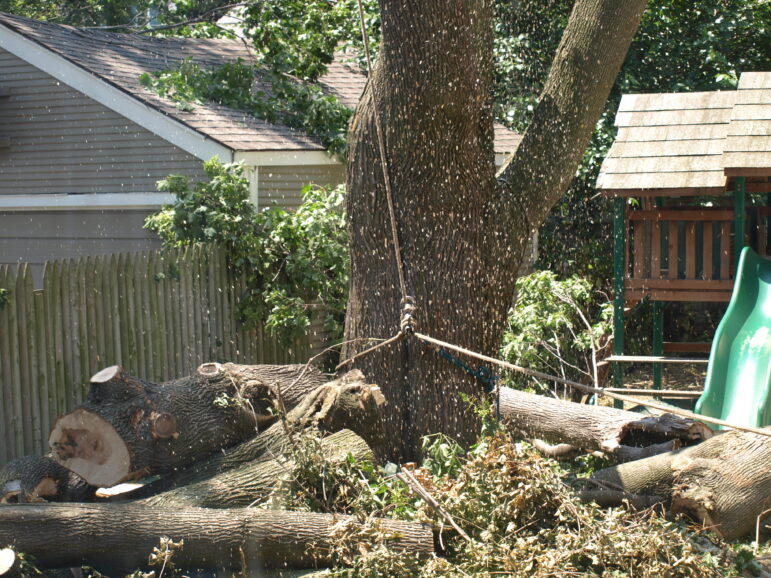By MOLLY WRIGHT
Capital News Service

Courtesy photo.
Molly Wright (left) Grace Huber (middle) and Sean Wright (right) pose with tire swing and downed maple branch.LANSING – If a tree falls in a forest, it can be argued that it does so silently. The silence connotes a peaceful ending in a landscape where the impacts are small.
But when a tree falls in a neighborhood?
Things change, and armies assemble.
From an early age, I have always loved being outside.
Though it would be remiss not to admit that I have the connection I do to nature because of its proximity to me. I was fortunate enough to grow up in a house in Royal Oak with a backyard, not just any backyard – but the backyard. The one where all the neighborhood kids came to play.
You see, we had a tree with a tire swing large enough to clear the top of our garage.
Its pendulum motion scaled the entirety of my suburban backyard and, when combined with the minuscule weight of my 8-year-old body, summoned such a vivid sensation of flying that every night I dreamt that I was.
When the tree fell, my friends and I found ourselves on my front porch steps, unable to look at the carnage that was my backyard, the splintered remnants of the 300-year-old maple that was my social life scattered everywhere.
We were having our first brush with the existential crisis that is the passage of time and the adjustments it brings.
“What do we even do now?” I asked, terrified of the mundane summer to come.
“Do you think this is the end of our childhood?” my friend replied, thinking the same thing.
“I think so,” I said, unwilling to be a child living in a tire-swingless world. As far as I was concerned, this was the kind of pain that put a chip on your shoulder and hair on your chest.
We were 8 and a little dramatic – it very much was not the end of our childhood. But it was a poignant reflection at the time — that at the very least, the coming summer would look different than in the years prior.
The tree stood for a year after the branch fell, condemning me to a seemingly endless sentence of reminiscing about a time when my house was “the house” in the neighborhood.
When the workers came to cut it down the next summer, among the sawdust, debris and chaos raining down came tens of large, fat, segmented white larvae. I was livid and thoroughly disgusted.
My 8-year-old mind quickly jumped to a sadistic form of environmental justice.
Earlier that year, in science class, we had learned about the power of the sun’s rays by building a solar oven with household objects. Made from a 2-liter bottle and a tinfoil satellite, the ovens were originally intended for cooking hot dogs.
I had other plans.
I snapped on gloves and went to battle, plucking the 2-inch larvae from the grass with disdain, their plump, translucent bodies filling my child-sized palm. Wriggling around in my hand, they were completely at my mercy – entirely unaware of what was to come.
I broiled my maggots for two days, hoping they would explode and leave polluted traces of the childhood I felt they had poached.
They didn’t, but I made sure to lay their bodies out as a warning to the others.
“Don’t come back. And DON’T touch any more trees,” I thought like a vigilante Lorax.
The grubs weren’t the culprits. They were larvae from the native reddish-brown stag beetle, which are often falsely blamed for the death of the trees they inhabit.
The larvae feast on trees that are already stressed, sick or dying. Living for 3-5 years, they play a vital role in the decomposition process and provide a food source for animals like raccoons and woodpeckers.
The adults grow to be around 1 inch, but males of the species can reach nearly 1½ inches due to their large jaws.
They can be found throughout the Northeast United States and parts of Canada and are harmless to humans.
Learning of the grub’s innocence, I wondered how I could have been so merciless at 8 years old.
And even if the larvae had killed the tree, wasn’t that just how nature works? Who was I to blame something that had no control over the conditions in which it lives its life?
Then I remembered an article I had read from the BBC questioning whether blame for climate change falls on corporations or consumers, examining how the language governing the debate has shifted toward consumers.
According to a 2017 report from the CDP (formerly the Carbon Disclosure Project), 70% of greenhouse gas emissions in the past two decades can be attributed to 100 fossil fuel companies.
Still, the lifestyles of Western consumers contribute to emission totals disproportionately.
So, are we to blame for the way we live our life, or do we simply have no control over the conditions created for us by the corporations which govern us? And what does my misguided vengeance against the larvae represent in greater society?
Yes, consumers can choose how they consume, but it is an illusion. Green options are often expensive, inaccessible or impractical. And don’t get me started on greenwashing.
Most consumers do not have the time, mental energy, money or resources to evaluate the environmental impact of every aspect of a product or service needed to sustain life.
We are told to turn the water off when we brush our teeth and turn off our AC units at night while Time Square runs full brightness during a heatwave and Nestle pumps 1.1 million gallons a day from Osceola County for less than $200 a year.
So, unfortunately, we have more things in common with larvae than anticipated: we are both the recipients of misplaced blame — left to roast as reparations for things beyond our control. We take the blame, the guilt and the shame that should be applied to the conditions created by corporations — just as the tree created the conditions for the grubs.
And we’re cooking because of it.
Molly Wright reports for Great Lakes Echo.

Maine.gov
Grub larvae.
Courtesy photo
Maple being cut down.